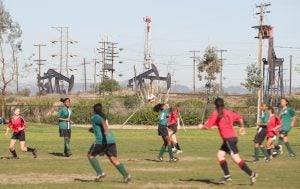
Tech for change video series: Backyard oilfields
This post is the first of EDF’s Tech for Change series, which spotlights the way pollution-sensing technology can protect public health and the environment in California. Watch part 2 here.
Imagine having an oilfield in your backyard. That’s a fact of life for many Los Angeles residents. Nearly 600,000 people in the city live within ½ mile of an active oil well, and the city is home to the country’s largest urban oilfield (view on Google Maps).
Living so close to active oil and gas facilities is not without its risks. Public health studies have shown that communities near oil and gas operations are at increased risk of exposure to harmful pollution. The problem is that a lack of pollution monitoring near these well sites means neighboring residents don’t know what’s leaking into the air they breathe.
[Tweet “Backyard oilfields put Californians’ health and environment at risk – new tech could change that. Here’s how.”]
We developed this five-part video series to demonstrate how advancements in sensing technology can provide real-time data about the pollution coming from oil and gas sites. Our hope is that by increasing access to pollution data, we can make great strides to help inform health research, improve oil and gas management, and protect communities.
Feature Image via Flickr











